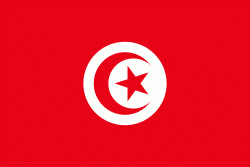Sidi El Hani (Sidi el Hani)
Sidi El Hani (or Sidi Al-Hani) (سيدي الهاني) is a town and commune in the Sousse Governorate, Tunisia located at 35.67n, 10.30e. As of 2004 it had a population of 3,058. It gives its name to the largest lake of the governorate, a natural salt lake or salt pan (sabkha) in dry seasons, the Sebkhet de Sidi El Hani which is shared with between one and two other areas depending on precipitation and its maximum extent forms the official boundary with part of a third, Monastir Governorate. The town is 30 km south-west of the coast, its straightest connection being by Tunisian Railways, with a secondary connection by road, the P12 road which is a principal road to Kairouan from the A1 a few kilometres to the east. it is 19 km from Kairouan and 26 km from Raqqada.
During the Roman Empire Sidi El Hani was a Roman town of the Province of Africa Proconsularae. The remains a large amphitheater are still seen. The town was known as Quartz August (Street of Augustus) or vicus Augustii (the Village of Augustus) and was active from 30 BC to AD 640.
In Late Antiquity Sidi El Hani was the seat of a Christian Bishopric, and remains a titular bishopric of the Roman Catholic Church.
During the Roman Empire Sidi El Hani was a Roman town of the Province of Africa Proconsularae. The remains a large amphitheater are still seen. The town was known as Quartz August (Street of Augustus) or vicus Augustii (the Village of Augustus) and was active from 30 BC to AD 640.
In Late Antiquity Sidi El Hani was the seat of a Christian Bishopric, and remains a titular bishopric of the Roman Catholic Church.
Map - Sidi El Hani (Sidi el Hani)
Map
Country - Tunisia
 |
 |
| Flag of Tunisia | |
Beginning in early antiquity, Tunisia was inhabited by the indigenous Berbers. Phoenicians began to arrive in the 12th century BC, establishing several settlements, of which Carthage emerged as the most powerful by the 7th century BC. Carthage was a major mercantile empire and a military rival to the Roman Republic until 146 BC, when it was defeated by the Romans who occupied Tunisia for most of the next 800 years. The Romans introduced Christianity and left architectural legacies like the Amphitheatre of El Jem. In the 7th century AD, Arab Muslims conquered all of Tunisia (finally succeeding in 697 after several attempts starting in 647) and settled with their tribes and families, brought Islam and Arab culture to the local inhabitants, and since then Arabs became the majority of the population. Then, in 1546, the Ottoman Empire established control there, holding sway for over 300 years, until 1881, when the French conquered Tunisia. In 1956, Tunisia gained independence as the Tunisian Republic under the leadership of Habib Bourguiba with the help of activists such as Chedly Kallala, Farhat Hached and Salah Ben Youssef. Today, Tunisia's culture and identity are rooted in this centuries-long intersection of different cultures and ethnicities.
Currency / Language
| ISO | Currency | Symbol | Significant figures |
|---|---|---|---|
| TND | Tunisian dinar | دت | 3 |
| ISO | Language |
|---|---|
| AR | Arabic language |
| FR | French language |















